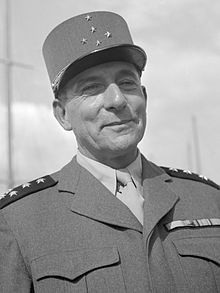Jean de Lattre de Tassigny | |
|---|---|
 General de Lattre in 1946 | |
| 32nd Chief of the Army Staff | |
| In office 30 November 1945 – 12 March 1947 | |
| Preceded by | Maurice Gamelin |
| Succeeded by | Georges Revers |
| Personal details | |
| Born | 2 February 1889 Mouilleron-en-Pareds, France |
| Died | 11 January 1952 (aged 62) Paris, France |
| Spouse | Simonne Calary de Lamazière |
| Children | Bernard de Lattre de Tassigny |
| Alma mater | Lycée Sainte-Geneviève École Spéciale Militaire |
| Nickname | Le Roi Jean |
| Military service | |
| Allegiance | |
| Branch/service | |
| Years of service | 1911–1952 |
| Rank | Army general[a] |
| Unit | |
| Commands | List
|
| Battles/wars |
|
Jean Joseph Marie Gabriel de Lattre de Tassigny[b] (2 February 1889 – 11 January 1952) was a French général d'armée during World War II and the First Indochina War. He was posthumously elevated to the dignity of Marshal of France in 1952.
As an officer during World War I, he fought in various battles, including at Verdun, and was wounded five times, surviving the war with eight citations, the Legion of Honour, and the Military Cross. During the Interwar period, he took part in the Rif War in Morocco, where he was again wounded in action. He went on to serve in the Ministry of War and the staff of Conseil supérieur de la guerre under the vice president Général d'armée Maxime Weygand.
Early in World War II, from May to June 1940, he was the youngest French general. He led the 14th Infantry Division during the Battle of France in the battles of Rethel, Champagne-Ardenne, and Loire, until the Armistice of 22 June 1940. During the Vichy Regime he remained in the Armistice Army, first in regional command posts then as commander-in-chief of troops in Tunisia. After the Allied invasion of French North Africa in November 1942 the Germans invaded the unoccupied portion of France; de Lattre, Commander of the 16th Military Division at Montpellier, refused the orders not to fight the Germans and was the only active general to order his troops to oppose the invaders. He was arrested but escaped and defected to Charles de Gaulle's Free French Forces at the end of 1943. From 1943 to 1945 he was one of the senior leaders of the Liberation Army, commanding the forces that landed in the South of France on 15 August 1944, then fought up to the Rivers Rhine and Danube. He commanded large numbers of American troops when the US XXI Corps was assigned to his First Army during the battle of the Colmar Pocket. He was also the French representative at the signing of the German Instrument of Surrender in Berlin on 8 May 1945.
He became Commander-in-Chief of French Forces in Germany in 1945, then Inspector General and Chief of Staff of the French Army. In March 1947 he became the vice-president of the Conseil supérieur de la guerre. From 1948 to 1950 he served as Commander-in-chief of the Western Union's ground forces. In 1951 he was the High Commissioner, commander-in-chief in Indochina and commander-in-chief of the French Far East Expeditionary Corps, winning several battles against the Việt Minh. His only son was killed there, and then illness forced him to return to Paris where he died of cancer in 1952. He was elevated to the dignity of Marshal of France posthumously in 1952 during his state funeral.
Cite error: There are <ref group=lower-alpha> tags or {{efn}} templates on this page, but the references will not show without a {{reflist|group=lower-alpha}} template or {{notelist}} template (see the help page).
- ^ Government of the French Republic (2 September 1912). "Decision on transfers in the active army". gallica.bnf.fr (in French). Retrieved 21 September 2020.
- ^ Government of the French Republic (10 March 1916). "Decision on transfers in the active army". gallica.bnf.fr (in French). Retrieved 21 September 2020.
- ^ Government of the French Republic (22 August 1926). "Decision on transfers in the active army". gallica.bnf.fr (in French). Retrieved 21 September 2020.
- ^ Government of the French Republic (5 October 1927). "Decision on transfers in the active army". gallica.bnf.fr (in French). Retrieved 21 September 2020.
- ^ Government of the French Republic (22 July 1929). "Decision on transfers in the active army". gallica.bnf.fr (in French). Retrieved 21 September 2020.
- ^ Government of the French Republic (20 June 1935). "Decision on transfers in the active army". gallica.bnf.fr (in French). Retrieved 21 September 2020.